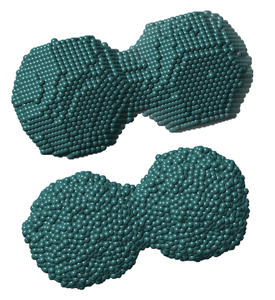

02/25/2020

Adapted from Ref. 1 and licensed under CC BY 4.0 © 2019 Y. Tian et al.
Metal nanoparticles with a disordered, glass-like structure coalesce faster than conventional metal nanoparticles that have a crystalline structure, experimentalists at the AIMR have discovered1. This finding has significant implications for their use, since the properties of nanoparticles depend greatly on their size.
Metallic glass nanoparticles are attracting much interest because of their potential for use in a wide range of applications, including catalysis, biomedical materials and the strengthening of composite materials. Unlike conventional metal nanoparticles, which have a regular, crystalline structure, metallic glass nanoparticles have a disordered arrangement of atoms.
Due to their tiny size, all nanoparticles are inherently unstable and they often tend to merge with each other to reduce their surface energy — in much the same way that two small bubbles will coalesce to form a larger, more stable bubble. Known as coarsening, this mechanism has been extensively studied in conventional metal nanoparticles because it leads to degrading of their physical and chemical properties. But the coarsening mechanisms of metallic glass nanoparticles remain largely unknown.
“The coarsening mechanism is important for nanoparticles because it determines their sintering kinetics and their subsequent stability,” says Yuan Tian, who is the first author of the study.
Now, by using a state-of-the-art in situ heating transmission electron microscope that allowed them to observe nanoparticles coalesce stably at high temperatures, a team led by Mingwei Chen of the AIMR at Tohoku University has found that metallic glass nanoparticles coalesce much faster than their crystalline counterparts at temperatures of a few hundred degrees Celsius.
“This special coalescence behavior of metallic glass nanoparticles came as a surprise to us,” says Tian. “This new aspect of metallic glass nanoparticles is important for informing their future study.”
To gain more insight into the coarsening mechanism, the team also performed computer simulations of the nanoparticles. They found that the greater mobility of surface atoms and the isotropic structure of metallic glass nanoparticles are the main drivers of their faster coalescence compared to their conventional cousins (see image).
“During coalescence, metallic glass nanoparticles keep their round shape, whereas crystalline nanoparticles gain sharp edges,” explains Tian. “The different morphologies of crystalline and amorphous nanoparticles give their surface atoms different mobilities, and this, in turn, gives rise to their different coarsening mechanisms.”
The team intends to investigate the coarsening process of larger metallic glass particles. “We plan to extend this study to larger scales because we anticipate that the coarsening mechanism will change when the particles are larger than about 10 micrometers,” says Tian.
This research highlight has been approved by the authors of the original article and all information and data contained within has been provided by said authors.